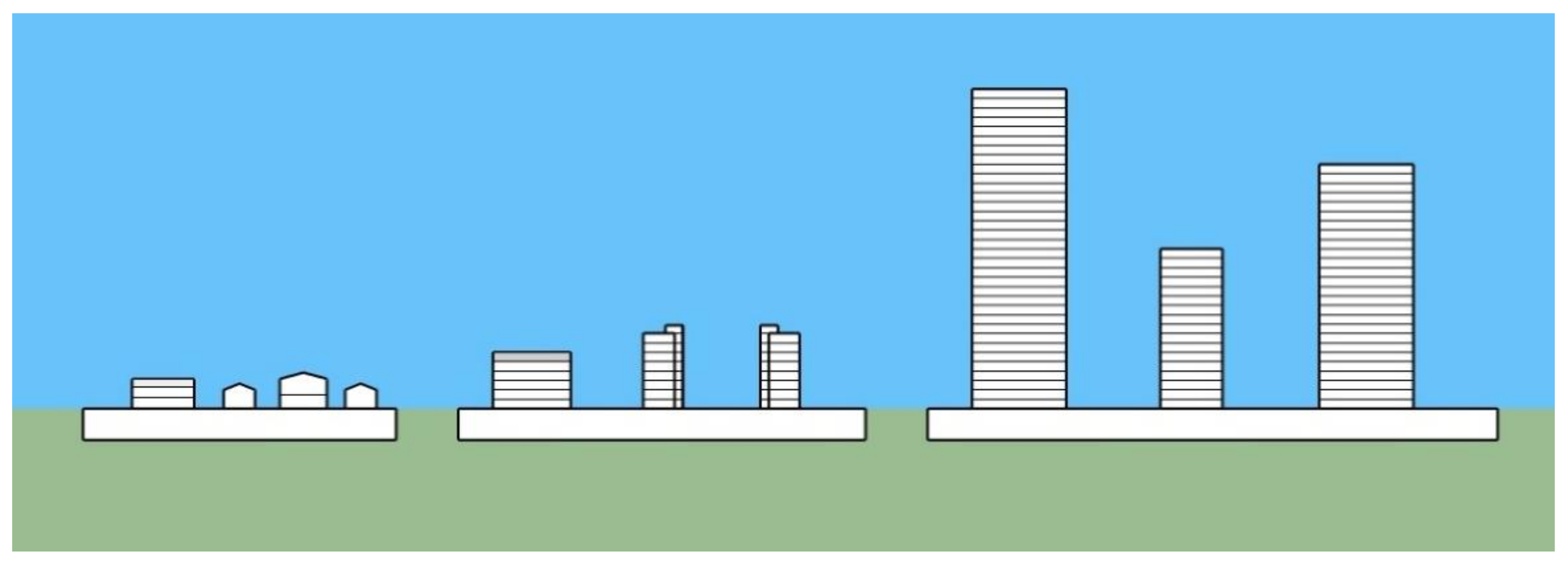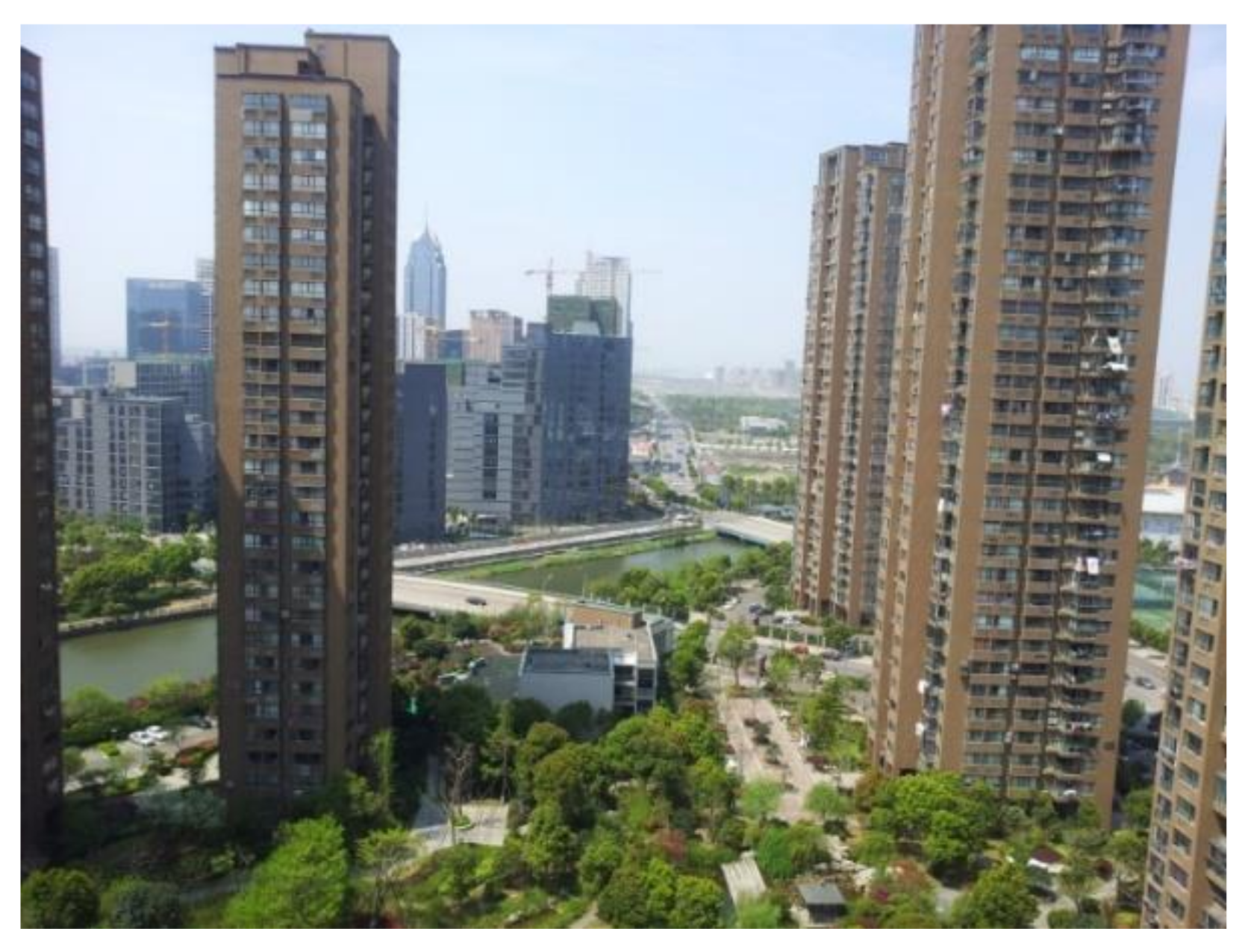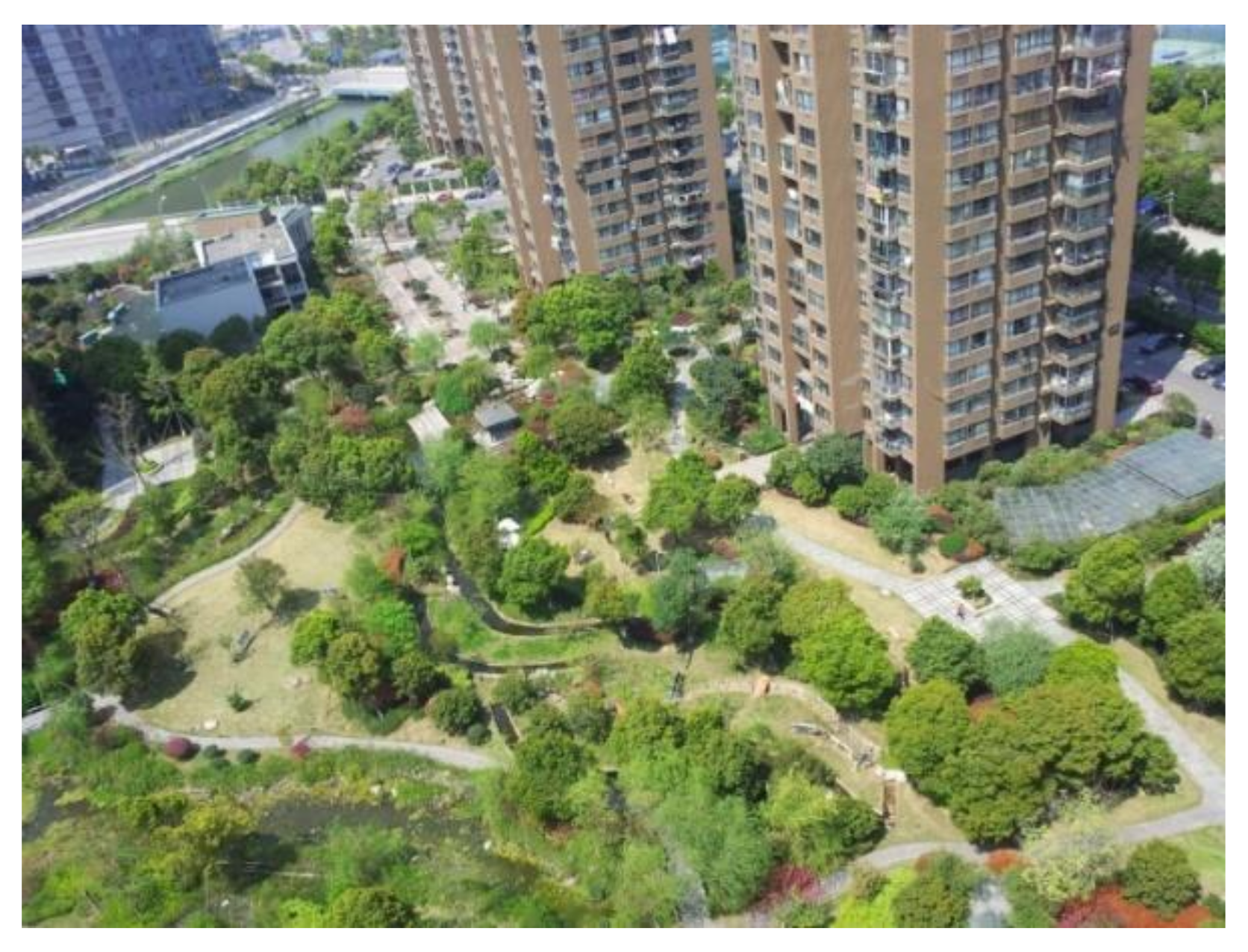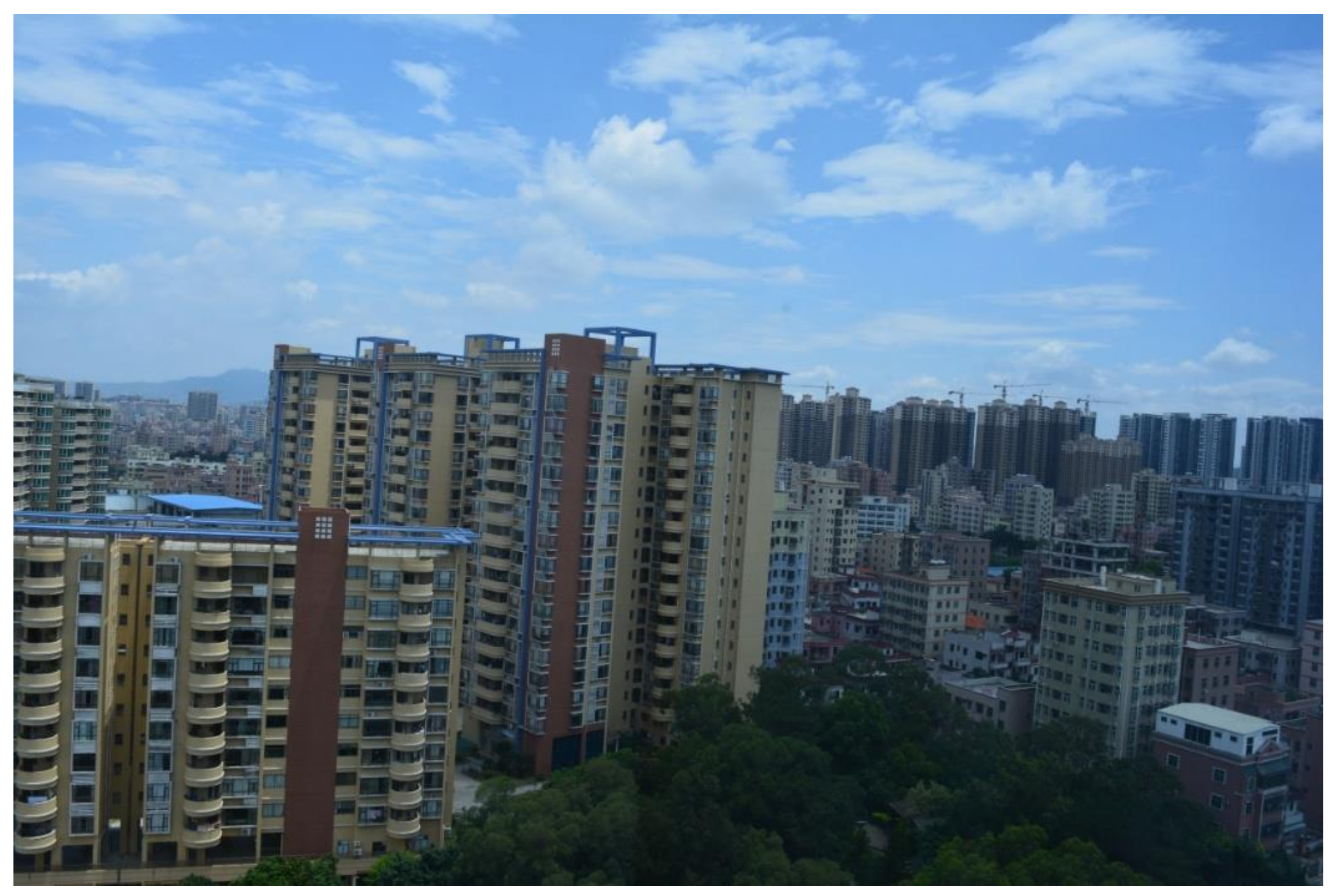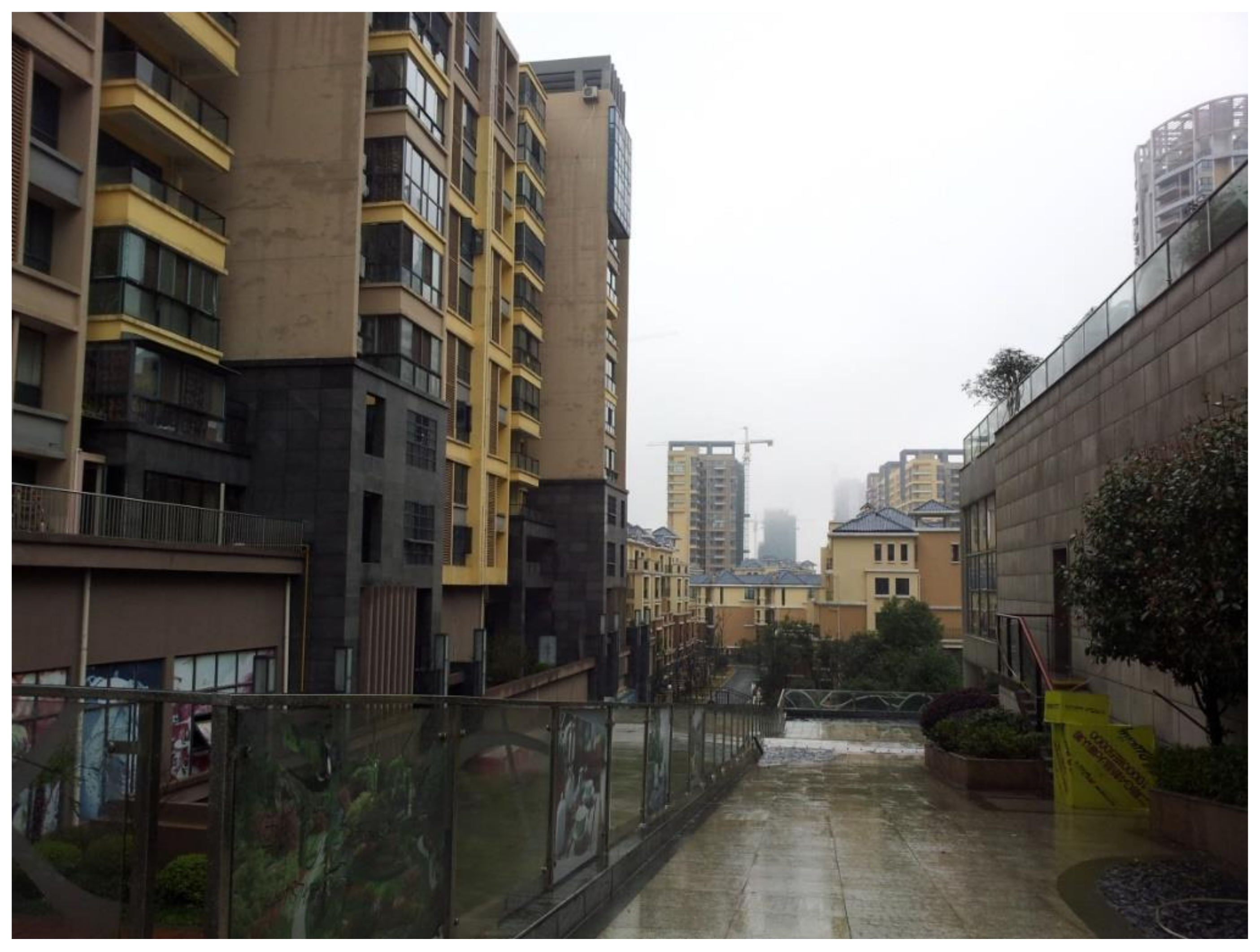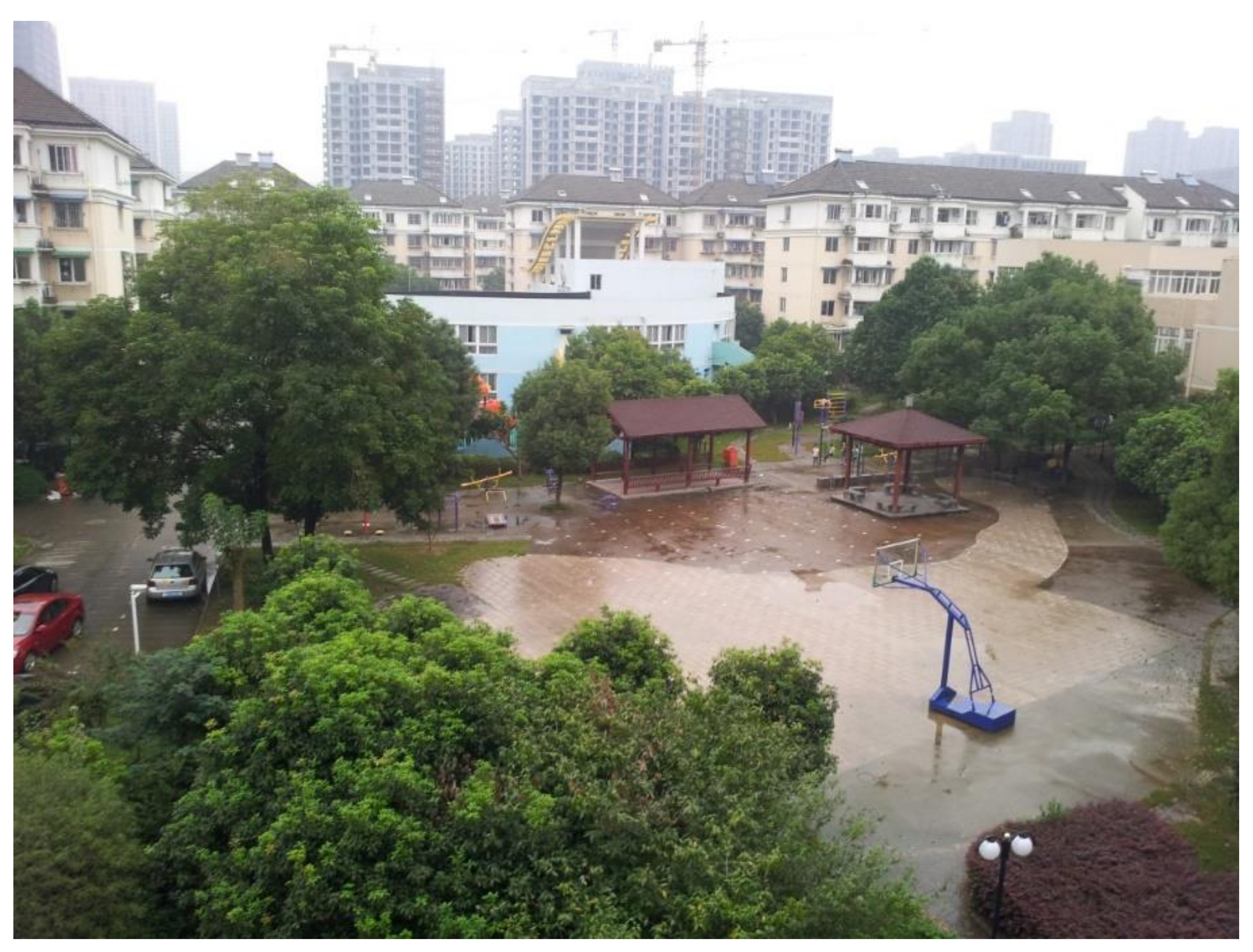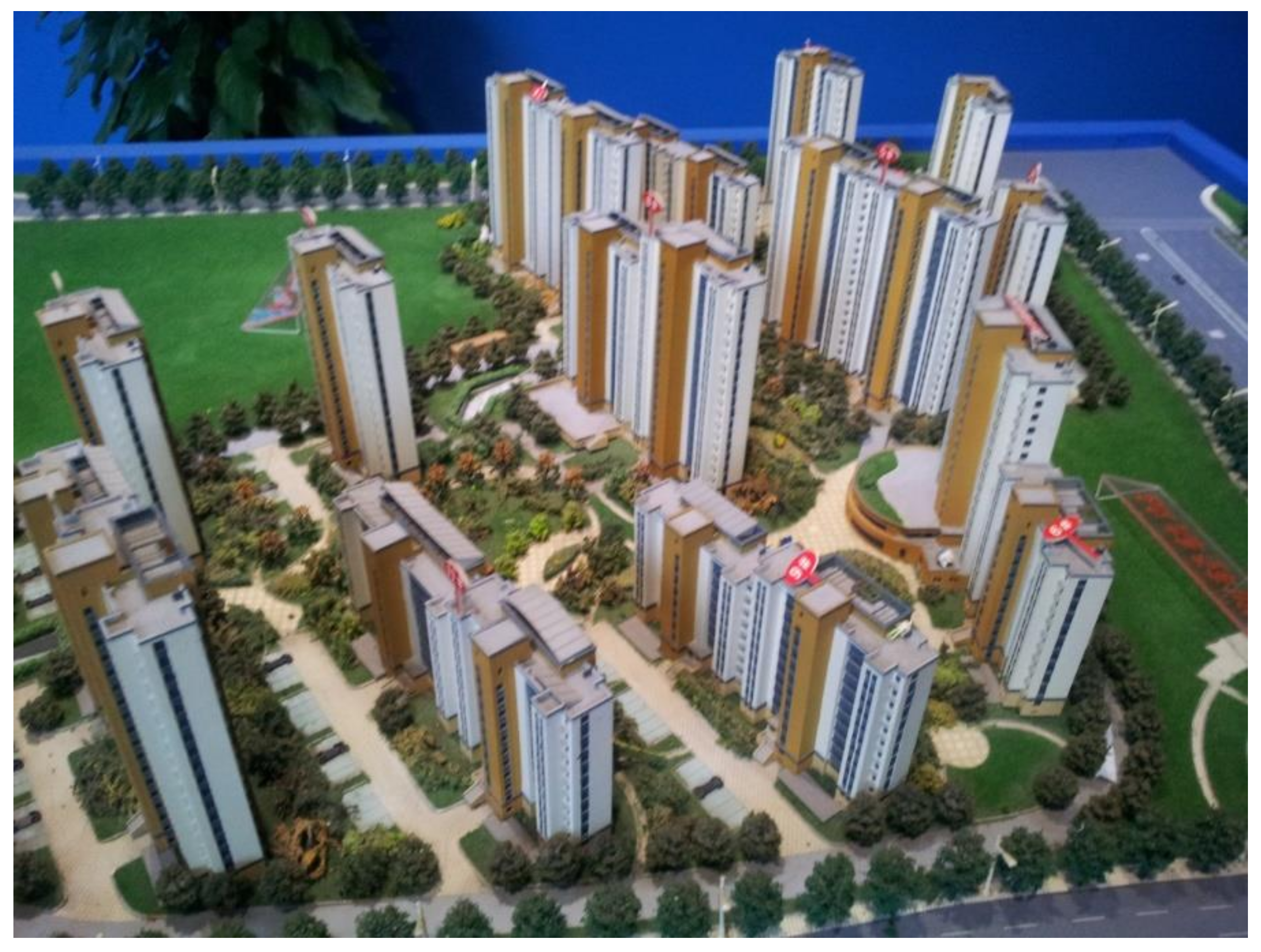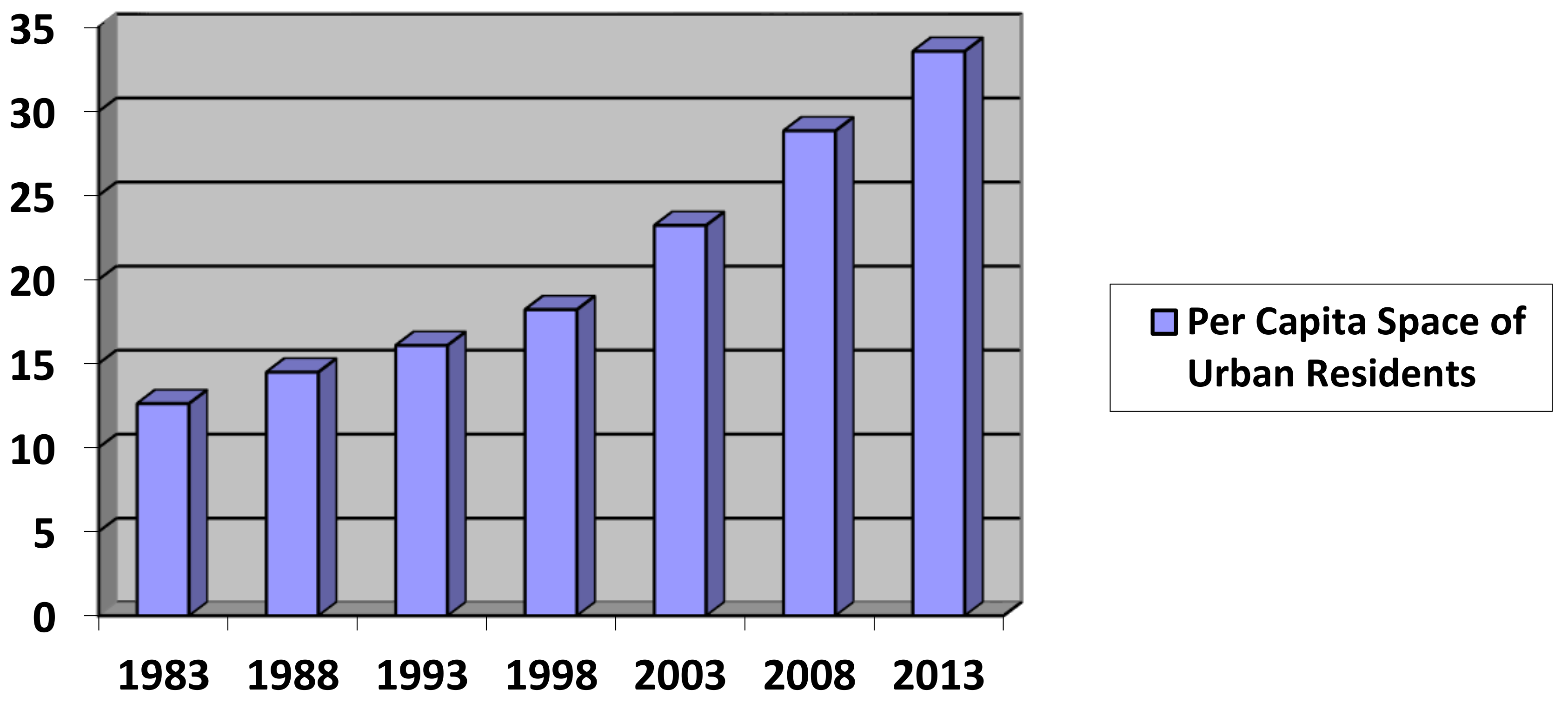1. Introduction
By simply observing many contemporary urban residential communities and districts of major Chinese cities, we can identify common features of contemporary urban housing, often with no defined edges [
1], minimal characteristics, generic landscaping and inhumane scale. Such developments are often at large-scale planning and with insignificant and/or poor quality urban design considerations. A typical city landscape in such cases can belong to any medium to large scale city across the country or even similar to other major cities in the contexts of Asia and South America with similar development patterns. This process of development embraces a mixed variety of new medium- to high-rise housing blocks that in return increase the overall density of urban environments [
2]. Some of these aspects are indeed associated with China’s land policy, and particularly urban land policy, where individual land ownership does not exist. Such policy, unique to only few countries, has impact on housing development and provides an easier passage to mass housing and large scale housing development typologies. It is therefore arguable that such approach to planning in urban housing creates new challenges in design and development. Hence, there are substantial urban design challenges that are developed as part of recent and current urban housing transitions in China. These challenges are discussed in this paper to highlight issues of common practices in China. These ultimately investigate the role of urban design controls and measures for urban housing projects that can lead to alternative urban design and planning practices, which are highlighted below.
Urban housing transitions in China differ to rest of the world from various perspectives. Over the last few decades, China has experienced an unprecedented urbanisation with a very high influx of rural-to-urban migration. This factor, unlike any other country, puts major pressure on city environments. Therefore, the transition in urban housing during this period has shown not only physical and morphological transitions—i.e., from low rise traditional to modern high rise buildings—but also transitions in density, demography, spatial design and household formation. From the morphological transition perspective, the transition is probably the most apparent one as it has altered the urban landscapes of cities significantly. Most of this transitional impact is also seen on new physicality of urban housing areas and household formation, mainly from family-based single housing to multi-storey mass housing and to mid- to high-rise residential communities that are also known as residential compounds. Such residential compounds are mostly gated and, in terms of their spatial formation, are often disconnected from other urban blocks. A typical residential compound can include more than 1000 units and is no longer developed in a low-rise pattern, unless it is specified for new high-end low-rise villa housing. From the spatial transition perspective, we can see several changes, including: spatial use transition from communal spaces to gardens and decorative landscaping such as fountains, water features and greenery; configuration transition from permeable urban living areas to gated communities with allocated gates/entrances (often secured), podiums of commercial units alongside the urban blocks, and with green buffer zones alongside some of the edges; services transition from on-surface provisions for parking spaces to extended underground infrastructures; and finally spatial quality transition, from mostly hard surfaces to mixed spatial use and mostly green surfaces. Finally, much of the transition is based on China’s demographic transition, with particular changes from the mid-1960s to early 1970s that resulted in low birth and death rates. This intensified with the introduction of the one- child policy in 1979, which further changed the already-changing demographic patterns of Chinese cities. Much of the focus was then on smaller family units and community-based living environments. This major change, combined with the scenario of rural-to-urban migration, had significant impact on density of cities resulting in formation of new urban housing typologies, new spatial configurations and new urban design principles for urban housing projects across medium to large scale cities of China. Some of these principles were then developed into urban design controls that are fundamental to planning and design of residential compounds, housing units and their immediate living environments.
Urban design controls—for both architectural and landscape design—are a set of guidelines, criteria and building methods that developers, planners and designers should comply to the requirements of statutory authorities. From a policy perspective, these controls are regarded as development controls [
3]. These controls focus on spatial layouts and design patterns that eventually, and at a larger scale, can alter the urban landscape of cities and the living environments. The often polycentric development in Chinese cities [
4] offers development of multiple centres and sub-centres with similar planning and design patterns. Such approach has changed urban landscapes of Chinese cities, which is partly due to significant urban housing transitions of the past four decades in China. In this respect, this paper investigates recent (since the 1970s) and contemporary urban housing development projects (mostly after the 2000s) and the transitions that have taken place over this period. Prior to this era, most Chinese urban housing remained at traditional typology or small-scale housing community development. Since the 1970s, new urban housing typologies emerged and new spatial configurations and urban design principles started to shift urban landscapes of Chinese cities. Throughout this process of change, huge alternations were made to spatial qualities and physicality of urban housing environments. These changes can be seen in the earlier housing development patterns [
5] as well as in contemporary patterns and housing typologies of the last two decades. The era of the 1970s onwards is selected as an era of major transition in urban housing in China. Since the 1970s, we see little evidence of traditional housing development in Chinese cities. The form in which urban housing has developed since then is mainly to accommodate the large influx of new urban residents mainly due to rapid rural-to-urban migration. Before this era, this migration was steady and did not have a major impact on densification of cities, as it did mainly in the later years of the 1980s and 1990s and particularly after the era of Cultural Revolution in China.
The transition from traditional urban housing (before the 1970s) to early stage of mass housing development in China in 1970s and afterwards is perceptible through major physical, morphological, and spatial transformations. The policy of no private land ownership had an impact on this transformation, particularly from the spatial dimension. Hence, since the 1970s, most of the urban housing is developed in the form of community development and not based on individual housing development. This factor has shifted spatial configuration of urban housing communities, and developed away from a single land use of individual units, to single land use or mixed residential and communal land use of residential districts or residential compounds of multiple units and multiple flooring. Hence, the impact is visible on placemaking approach to urban housing, with more community-based residential areas in the early phases (1970s–1990s) and towards larger scale gated communities afterwards (the late 1990s to now). Fundamental to urban design principles, this transformation of placemaking approach has reshaped many Chinese cities and urban environments, mainly from traditional and low-rise living environments to modern and mid- to high-rise residential compounds. In this respect, urban design controls play a major role in shaping and reshaping these urban areas that often account for majority of the city’s built environments. Therefore, in this paper, these transitions are explored with qualitative analysis of urban design controls, and how effective they have or have not been in this process of rapid change and restructuring of cities in the context of China. Similar to earlier discussions by Trancik on modern architectural and urban design [
6], much of China’s urban housing transitions of the last few decades follow the same direction but in a more drastic approach. The impacts are then on functionality of living environments, morphology and spatial urban design of residential areas. The typical common, segregated master planning approach to urban housing is a direct definition of modernist urban design [
6,
7], through which common modernist urbanism practices both structurally and spatially alter our urban residential environments. The production of such transitions is what we currently see across most medium to large scale cities of China, i.e., generally as medium- to high-rise urban housing of similar building design and spatial configuration. Hence, the main argument of this paper lies at identifying and understanding the impacts of urban design controls on China’s contemporary housing, and in particular through its main urban housing transition period of the 1970s to now.
This paper first investigates China’s housing transitions and typologies and then further explores challenges and issues generated from lack of urban design controls in policy and practice. Afterwards, the paper discusses the key features of planning and design as part of urban design controls and measures in recent and current practice. Through these detailed discussions, this paper focuses on key positive and negative impacts of housing transitions on contemporary Chinese urban planning and design. Examples are given for both positive and negative impacts, from which this paper assesses common issues and challenges. These are focused on how Chinese cities are developed and developing, societies are shaped and shaping, and places are emerged and emerging. Some alternative routes are then discussed to open up discussions for possibilities of better urban design controls in contemporary Chinese urban housing. These can be regarded as urban design guidelines and towards potential design control instrument for China’s housing development process. Before doing so, the study highlights housing transitions and typologies in Urban China. By discussing housing transitions, the study explores the housing development transitions that have specifically changed the urban landscapes of Chinese cities over the last few decades. The changing landscape of Chinese cities are very much dependent on these widespread transitions that have shaped new urban living environments, new spatial configurations and new physicality of the cities in China.
2. Background Knowledge: Housing Transitions and Typologies in Urban China
The study of housing patterns in China is often conducted at various levels and with multiple objectives [
8], including the following three key overlapping aspects: (1) research on housing reform policy [
9,
10,
11], where issues of policy change and development are extensively discussed and analysed; (2) research on socio-spatial patterns of Chinese cities and urban housing [
12,
13,
14,
15,
16,
17], which is a more recent topic of research related to issues of space and social qualities in the urban environments; and (3) arguably the well-known gap of literature and research on individual residential units and affordable housing [
18]. The literature focuses on these aspects from multiple objectives of policy, practice and development. As a unique example, the case of China serves as an example of multi-objective research on urban housing, stretching from urban housing policies to detailed design. As an example, urban design controls are explicitly set as guidelines for both design practices and policies on urban housing. Such controls, as studied further in this paper, reflect on the overall formation of urban landscapes, urban patterns, and spatial configurations of the city environments. All these aspects are developed over a transitional process that has taken place mostly since the early 1970s and with mass housing projects across major cities of China.
In one of our earlier studies on China’s urban housing, three distinguishable housing typologies and patterns were identified, with a possibility of one emerging new typology as the fourth [
8]. These three main urban housing typologies are defined as: (1) traditional low-rise housing models or Village in Cities (ViCs); (2) affordable housing of 6–8 floors; and (3) medium- to high-rise housing in gated communities or Small Residential Development (SRD) zones, often 10+ floors and mostly in the range of 25–40 floors depending on in which city or where they are located. The range changes depending on particular city regulations or density regulations of particular districts within a city. The fourth, and newest, emerging model is a low-rise and high-end villa housing typology, which has become more popular and at higher prices over the last few years. This fourth typology, however, is not part of the investigation of this paper as they have very little impact on urban landscape of Chinese cities. This is mainly due to their location being on the outskirts of cities or within the larger mixed residential compounds. The former is introducing the new challenge of urban sprawl in China, while the latter provides an opportunity for mix of typologies in a particular area.
Figure 1 illustrates the three main housing typologies in a sectional sketch drawing, demonstrating a transitional development from low rise traditional housing (left section,
Figure 1) towards the earlier mass housing typology (middle,
Figure 1), before reaching the contemporary model of low- to midrise urban housing (right,
Figure 1). The latter is a common example of a gated community housing compound that often accommodates many residents, with low surface coverages and higher densities. In this transition process, we can often see substantial changes of floor area ratios that have been found to be eight times the traditional layout [
19].
As shown in
Figure 1, this urban housing transition is a tangible transition in housing development in China, from low-rise (often 1–4 floors) traditional housing towards low- to mid-rise (6–8 floors) and then towards mid- to high-rise housing towers. In this paper, the argument is on the role of urban design controls and their impacts on contemporary urban housing development. Since such controls are taking place at large scale, they have already regulated multiple housing redevelopment projects in most major cities of China. As a result, it is already evident that contemporary urban housing patterns are re-shaping the urban landscape of cities; from planning to detail design levels. Nevertheless, there is still scope for changes or modifications of these urban design challenges that can potentially lead towards formation of new urban housing typologies, new design practices, and reformed urban policies.
Nowadays, in most major urban areas, low-rise traditional housing areas are either replaced by new development or are renovated to different functionalities [
20,
21,
22]; for example, in most cases, these traditional areas are redeveloped or reused as public buildings such as exhibition spaces and retail; some of the affordable housing (mainly from the 1980s, 1990s and early 2000s) remain in various parts of cities; and the new medium- to high-rise residential towers are almost all over major Chinese cities. Differences between these three typologies are not only in their physical form and verticality, but also with a range of urban design considerations that are assessed in this study. These are thoroughly discussed below, where this paper highlights key positive and negative impacts of housing transitions on contemporary planning and design of Chinese cities.
3. Challenges and Issues of Urban Design Control on Urban Housing Transitions in China
Currently, China’s city planning and urban design are facing new challenges. These challenges have developed mostly in the last 2–3 decades, during which major transformation of the urban housing system has had impact on urban development planning, capital investment and rapid growth of the urban population [
12,
23,
24,
25,
26,
27]. Some of these transformations have major implications on social and spatial attributes of urban housing [
28]. More importantly, China’s market-oriented economy reform has impacted on internal structure of cities and has changed many urban landscapes [
21,
29,
30,
31]. In major cities, the shift has been so significant that urban redevelopment projects have also changed some of the existing socio-economic patterns and spatial qualities of residential neighbourhoods. These impacts stretch from city-level and neighbourhood-level planning to detailed design of residential compounds or districts.
In addition, most design decisions driven from the Chinese local planning (state-owned) and design institutes (not state-owned but associated to the governmental units) or research centres (both state-owned and not state-owned) do not offer any strong guidelines on detailed design and often remain at the comprehensive design level, where focus is mostly on solutions at the urban planning level. As a result, it is less likely to have effective urban design controls without the role of detailed design guidelines. The position of urban planning bureau is close to the local governmental decision, as they hold the highest power in decision making at the local level. Under the umbrella of the planning bureaus sit several research units or centres that focus on separate urban and rural matters, including housing studies and design controls. The urban housing bureaus, often associated with the urban planning bureaus, also play a major advisory role to the local government. The design institutes normally sit within or associated to the local universities, are the advisory and consultancy unit to the local governmental units. This structure is seen to be common in selected cases in this study. Based on the conducted surveys of urban housing compounds in four cities of Changsha (Central-South, inland), Ningbo (East, Coastal), Shenzhen (South, Coastal) and Zhuhai (South, Coastal), we found that there also seem to be tangible common practices between the urban housing projects of all four cities. These practices lack detailed design measures in several aspects of detailed design and planning, some of which are analysed here.
3.1. Urban Green Landscaping at City Level and Common Beautification of City Environments
Landscaping, and particularly green landscaping, plays a major role in creating quality urban design. In the process of housing transition in China, green landscaping has shifted from minimal green environments of traditional urban areas (e.g., often linear green spaces or within the inner courtyards of houses) to large open green spaces in the central parts of mid- to high-rise gated communities [
1]. The new green landscaping at city level is very much appreciated as a move towards various initiatives, such as, “harmonious development” (Yu, 2014), “urbanisation and the eco-environment” (Wang et al., 2014), “ecological and environmental protection projects” (Gu et al., 2012), and the well-known “ecological civilization” (first used by President Hu Jintao in 2007). They also have had major impact on housing prices in Chinese cities (Jim and Chen, 2006). However, some of this green landscaping lacks functional and/or ecological qualities and is merely used for common beautification of city environments. This has ultimately caused smaller footprints for new housing towers with a high-rise typology, i.e., less surface coverage is given to housing blocks themselves [
19]. This common practice is very much visible in most master planning projects, where designing the green space is not necessarily done to replace grey areas or add quality to spatial uses of the urban environments. In our earlier study of urban housing blocks in China [
19], there are exploration of possibilities for various design opportunities with various footprints (also known as Surface Coverages or SCs), floor-area ratios (FARs), and green-to-grey ratios for Chinese urban residential blocks. In this study, however, a major criticism is given to the less effective role of urban design controls on development of green landscaping in oppose to development of quality urban places. As shown in
Figure 2 and
Figure 3, the green spaces are mostly spaces between the buildings and are often functioning as a layer over the underground infrastructure of car parking and other services [
19].
Figure 2 and
Figure 3 represent one of these contemporary mid-to-high urban housing compounds, where the overall surface coverage of the building blocks are below 30% of the overall block size.
3.2. Urban Pattern and Common Practice of Grid System in Non-Historic Cities
Generally, the urban grid system provides choices of patterns and urban block layouts. For Chinese urban housing, this change of grid pattern is visible; that is, for non-historic cities, from organic pattern and compact layout of traditional housing areas [
21] to new and large-scale grid pattern of gated communities [
1]. Therefore, it is arguable that such restructuring has been in favour of restructuring the overall urban form of Chinese cities, in which process of change from low-rise compact housing to high-rise and dense housing has shifted the overall urban landscape as well as the scale of residential compounds. In recent decades, this transition has become a common practice through which urban design measures have become less impactful and transportation planning has become more robust in favour of large-scale planning projects. As an example,
Figure 4 demonstrates a typical repetition pattern of urban housing, where the urban blocks are often similar in terms of their detailed design, planning arrangements and transportation network.
3.3. Functional Zoning Planning and Lack of Integration between the Urban Blocks
Functional zoning planning plays a significant role in how cities have developed and are still (re)developing in China. In major cities, there are often large urban blocks 400–800 m long, where façade interaction is minimal. Although some large-scale housing developments offer linear podiums of commercial uses on the ground floor and/or at the street level, there remains a common practice of segregating blocks as part of the functional zoning planning of cities. As a result, there is no integration between most urban blocks in Chinese cities, through which developers often gain excitement to offer enclosed havens and urban enclaves of large-scale housing development. By doing so, an Americanised car-friendly model of urban planning is in place, where a rigid and wide transportation network separates the urban blocks from one another, and where the urban blocks are gated and disconnected in most parts of the city. This lack of integration highlights the weakening role of urban design controls and how they should in fact play a role in developing a less zoning approach than the current model of development.
3.4. Large-Scale Planning and Common Issues of Permeability and Legibility
As discussed earlier, most contemporary urban housing projects in China are taking place at master planning urban design level, some of which are large enough to accommodate 10,000+ residents in one residential compound. While the four edges of most of these residential compounds are surrounded by wide network of roads, each development may appear as an island (i.e., urban enclave) amid large road intersections. As a result of such large-scale planning, there are significant urban design issues of permeability and legibility through and within the new housing development. Lack of permeability in blocks started appearing in some of the later affordable housing compounds of the 1990s, where the concept of enclosed and secured gated communities took over the previously-permeable and traditional urban residential areas [
1]. This approach, at a larger scale of a super block configuration (i.e., where the urban block size is beyond 400 m × 800 m) can create major impact on mobility, transportation network, and connectivity between the urban spaces of the residential areas.
Figure 5 is a representation of one of these super blocks where a gated community of 1.2 km by 1.0 km can become an enclave of its own. The multiplication of such planning approach ends up with a combined rigid transportation network and multiple large-scale residential enclaves.
3.5. Car-Friendly City Environments and Common Practice of Undefined Edges
Through the assessment of most Chinese urban housing compounds (commonly in the four studied cities), we found significant similarities with the European cases of mass housing developments (and estate housing projects) of the 1950s and 1960s; with car-friendly environments, lack of walkability and undefined edges. In most contemporary cases, the distance from edge of the road to housing units are approximately 30–40 m with two rows of pedestrianised pavements, two sets of green landscaping areas and a front edge of commercial unit positions at the podium of some housing compounds. While this helps to create a buffer zone between the roads and residential units, it also creates places with undefined edges and unused outdoor spaces that are commonly used for surface car parking or extension of commercial units to pedestrianised areas. As a common example of design practice, this poses a threat on how spaces are utilised and edges are defined. In such cases, car ownership and usage is encouraged, where we can significant increase in the last few years. More details are discussed in
Section 6.
3.6. Homogeneous Housing Developments and Lack of Community Characteristics
In housing transitional process of contemporary Chinese cities, there is a trend for homogenising housing developments [
32] that are mainly gated, medium- to high-rise and disconnected from their neighbouring blocks and/or their immediate context [
32,
33,
34,
35]. This homogeneous model is caused by rapid replacement of most low-rise traditional housing typology and low- to mid-rise affordable housing compounds [
8,
22]. This major transition is mainly taken place over the past two decades and is still happening at a large scale. The growth in higher density residential compounds, smaller footprint of residential towers and the homogenous characteristics of new housing areas are major threats to urban housing communities. Moreover, the issues of social inclusion in the new typology of gated communities resembles the ideologies of enclave urbanism that focus more on private provisions [
36]. This also highlight the overall dominance of private services over public services [
6,
36]. Such matters have led to new discourse of urban fragmentation in Chinese cities, which is also related to issues associated with community building [
35] in the context of urban China. In most Chinese cities and particularly their residential areas or districts, there is a quest for identity through both physicality and sociality of the new urban housing development. Through urban housing transitions, this phenomenon has become a major urban design challenge that is difficult to reverse or change in a short time. There is also lack of design alternatives that allow very little flexibility in the urban housing market.
To conclude this section, we can argue that the above-mentioned six aspects are considered to be main common challenges and issues of urban design control on Chinese urban housing transitions (i.e., over the course of last four decades). In the following section, this paper introduces current issues of urban housing in China—from planning to detailed design. This analysis serves as an important argument as part of how urban design controls are and are not effective in shaping China’s urban housing. The following analysis section is structured based on a general overview of urban housing in China discussing planning and detailed design issues, and then towards the analysis of urban design controls and their positive and negative impacts on urban housing in China. In
Section 5, the analysis is divided into two parts of positives and negatives, with each having four themes associated with planning and detailed design of urban housing in China.
4. Urban Housing in China: From Planning to Detailed Design
In China, the role of urban planning bureaus is mainly to approve—but not to make key decisions on—urban block patterns and urban housing design at a district scale. Their focus is merely on planning regulations, providing permissions and delivery of guidelines on urban design controls, design characteristics, and layout of urban housing projects. Key aspects of land-use, density and height are addressed through this process, which are often based on provided benchmarks used for new development projects. Based on this process, a set of criteria is generated and given to developers for consideration at early stage of planning and design. Therefore, at the detailed design level, local design institutes often provide a set of design control and guidelines that are mostly in accordance with common practices; and some may change according to market demands or other potential trends. Nevertheless, in recent years, most design institutes provide detailed guidelines with support of their technical teams who study and analyse city statistics yearbooks, undertake simulation and modelling for issues of height-space ratios, road width calculations, car parking provisions and so on. In addition, in recent years, significant work is done in regard to setting up district-level planning and design controls, regular survey studies and comprehensive environmental assessments. However, there remains a lack of professional overview on comprehensive urban design controls that should be driven from local benchmarks and through case study scenarios.
As discussed in the
Section 3, two issues of large-scale planning for housing projects and the increase in gated typologies (or small residential districts) are amongst the most crucial planning and design control issues of Chinese cities. These two contemporary issues are extensively minimising the impact of urban design controls on urban housing projects in major or rapidly growing cities of China. The pro-planning approach to urban housing in China (mostly since the late 1990s) has promoted large scale housing projects in favour of gated communities that are now widespread across most Chinese cities. The minimal relationship and dialogue between urban planning bureaus and urban housing bureaus at the city level is affecting the overall urban housing planning and design. These are the state-owned units, often working as separate units and often located in major districts of the cities at a smaller scale. Further to this, there is also an apparent widening gap between sectors of planning and design, where the role of design is still minimal in shaping city environments in China. As a result, in this paper, the author argues in favour of urban design controls and measures and proposes for strengthening the role of detailed design in China’s urban housing development. By proposing this, the suggestion is given to shift the power from urban planning bureaus to urban housing bureaus, where we can then see more focus on urban housing characteristics, detailed design, and spatial configurations.
6. Discussion: Are There Any Alternative Routes?
To answer the above questions, one can argue for alternative routes—such as design solutions, measures and guidelines—to further develop China’s urban design controls for the benefit of current and future urban housing development. The current issues of high density and compactness in housing projects is not a new phenomenon in China, but the rapid physical growth of cities and the significant increase of floor-area ratios (FAR) in Chinese urban housing compounds (e.g., from 1.0 or 2.0 FAR to 4.0+ FAR in some contemporary cases) [
19] indicate new challenges in how far cities will continue to grow and how dense and compact urban areas can become. The combination of these two factors often puts pressure on quality of urban design and living environments. These aspects have significant impacts on life satisfaction [
49,
50] , subjective well-being [
51,
52], residents’ happiness [
52,
53] and hygiene and health [
49,
54,
55], inclusive of physical and mental health [
27]. These studies, some based on global cases and some in China, have thoroughly explored the negative impacts of dense, high-rise and poor-quality living environments on well-being and quality of life in the urban environments.
Here, based on the cross-analysis study of all available typologies in China, it is feasible to propose for a mid-rise solution with a surface coverage area of more than 20% (SC 0.2) as in gated communities and less than the traditional residential communities of over 50% (of the total area). In this regard, a 30 to 40 per cent surface coverage area is reasonable enough to revise and re-evaluate the followings: (1) notion of creating huge open spaces (often as green parks and man-made lakes) in the middle of housing areas; (2) the size of current individual block footprints (e.g., 50 m × 50 m), towards a more linear model to avoid single-sided ventilation and poor daylight for individual units; (3) the impact on creating undefined edges and unused public places; (4) the size of large urban blocks (minimum 100 m × 200 m) to achieve a better permeability through smaller blocks; and (5) the relationship of blocks with their context and integration between the blocks. Such urban design controls would help achieving a better performance for individual units (e.g., through better orientation, natural ventilation and natural lighting), a more inclusive approach to the overall design (e.g., through better spatial layout and improved landscape design) and an enhanced social cohesion for better urban living.
From the author’s surveys on two urban housing typologies of six-storey housing (from 1990s) and mid- to high-rise housing (contemporary housing projects) in the City of Ningbo, there is a significant increase in household energy consumption with a major load for cooling needs. The number of air-conditioning (AC) units is increased from two (in the 1990s typology) to four units (contemporary typology) in a typical three-bedroom apartment. This has increased the overall household energy consumption by 2–3 times compared to a typical traditional housing typology (estimated in average). We can argue that some of these changes are due to occupants’ behavioural changes, but some are associated with the overall design of contemporary houses. These design factors include units that are larger in size (on average and in comparison to earlier typology), lack of cross-ventilation for cooling effect, and inadequate number of openings for natural lighting. In four studied areas of this paper, i.e., sub-tropical regions of China, cooling load is becoming a major issue while heating load is still relatively minimal. Hence, we can argue that there are opportunities for design optimisation, as well as guidelines for cooling effect at meso- and micro-levels. Some of these factors can help to optimise green use of outdoor spaces, micro-climate design, and better air flow between and within the blocks (at meso level). Some other factors can be considered to optimise unit sizes, spatial uses, building layouts and ventilation strategies (at micro level). More importantly, technical evaluations at both levels are currently missing or very minimal in the current urban design controls. These should be addressed thoroughly as part of the overall Optimisation process.
In addition to the discussions above, we can also highlight some of the significant transitions over these few decades. For instance, in 2013, every household had an average number of 2.08 air conditioning (AC) units in the City of Ningbo [
41]. With the current increase, it is likely that this figure can go beyond 3.0 units by 2030 (estimated at 20% increase in every three years). Without consideration of new and/or alternative approaches to optimisation of some of the current housing typologies in Chinese cities, it is unlikely to change this trend of increase in energy consumption. On the other hand, most Chinese cities are experiencing significant increase in private car ownership. In the City of Ningbo, again as a typical example, the car ownership has doubled in less than four years (i.e., from 2009 to 2013), with just over 0.41 cars per household in 2013 [
41]. This sudden increase puts significant pressure on policy makers to revise household parking space provisions and road infrastructure of cities. Such decision-making scenarios have impact on the increase of car parking provisions in favour of car users. The trend is not only reversed but is expected to continue at a similar rate. With such trends of housing development in place, urban design controls are only likely to reflect on such provisions that will essentially shift the focus on provision of public services. This factor, as experienced currently, neglects the more important detailed design of housing typologies, housing blocks and housing performances. These will eventually move against possibilities for low-rise typologies, which are often low-cost, more energy efficient and more humane scale. While going back to traditional settings and urban housing typologies is almost considered impossible at the current pace of rapid urban development, there remains an opportunity for developing a new urban housing typology. This typology, as has been discussed from the analysis of existing typologies, could simply be between the contemporary high-rise and the more affordable mid-rise slab housing of 6–6 floors. To propose the right rationale for new alternatives, a new typology or several new typologies are needed to open new options for developers and end users. Otherwise, urban housing will continue to go up even higher physically, being denser on the surface, and poorer in quality of urban design.
The overall idea for this proposed alternative urban housing typology, ideally based on a mid-rise typology of approximately 10 floors, is generated from the above discussions. By exploring the negative and positive impacts or urban design controls above, it is important to highlight what can be gained from each of the existing typologies. Since the 1970s, there are visible elements of modernist design in Chinese urban housing, developed further from traditional housing towards a large scale residential and gated compound. The weaknesses that are highlighted here should be addressed for any potential typology design alternative that may develop in the coming years in China. The possibility for small urban block configuration remains as one of the main aspects for reshaping the residential communities. As shown in the example of Sino-Singaporean Tianjin Eco City [
56], breaking the larger urban blocks in to smaller scale could potentially lead into non-gated configuration, better permeability and walkability between and within the urban blocks. This can ultimately reduce car dependency, and better use of greenery in between the residential areas. By doing so, a better community-based spatial configuration can lead in to better ecological forms as well as a more human scale urban environment. The issues of density remain as a crucial factor that can be approached by reducing the building height and number of floors, and potentially increasing the surface coverages of the building blocks. As the Chinese cities are growing larger and becoming more polycentric, the issue of density is expected to be more crucial; hence, any design solution should respond to issues of car-friendly planning and dense sprawl that are widespread in many medium to large cities across China. The ideal way forward is to revise spatial configuration at first which respond to urban block size, and gated community structure of the residential compounds. The initial step is already taken by reversing the trend of gated communities in February 2016 [
57], which will be in effect in few years from now. The next steps are to revise density regulations and move towards a better scale in design and planning that responds more effectively to quality living environments. Some of these steps need to reflect on the past as it has been the focus of this research paper, and move towards potential alternative housing typologies in China.
Although this study was conducted through a range of case study observations, surveys and analyses, there are still limitations that can be addressed for future research on urban housing studies in China. In this field of research, it is essential to strengthen links with policy makers, practitioners and developers. In all contexts, these are considered the three key stakeholders whom have different strategies, standards and mindsets. As major challenges in doing such research, we have to be aware that developers often have very little involvement in such research programmes. Hence, their lack of support and/or willingness to provide information and cooperation is a major limitation for researchers to come up with comprehensive strategies and suggestions that can benefit a wide range of stakeholder groups. This conflict, as it has been noted through conducting this research in various cases, is mainly due to the increase of criticism on developers in China, and is partly due to developers’ lack of interest in academic research.
Other major limitations of the study are partly related to lack of access to various sites and documents/reports that can offer a wide range of choices and typology analysis in cities across China. This is particularly crucial for low-income and traditional housing areas [
58,
59], which are of interest to researchers in the fields of urban design, planning, and architectural theory [
60,
61]. Due to issues concerned with low-income housing areas (e.g., potential social issues and cases of informal settlements) and traditional housing areas (e.g., their often deprived physical conditions and security), the study is very much limited to selection of few accessible cases that are built in the 1970s and afterwards. Nevertheless, these four decades of urban housing transitions (1970s to 2000s) are extensive enough for researchers to raise issues of urban design controls, urban pattern changes and urban housing typologies in the context of China. Furthermore, we can argue that existing scholarly research has little to offer in terms of direct literature about urban design controls and various Chinese urban housing typologies. Such factors can be unfavourable to accomplishing a comprehensive research study, while study of multiple cases and multiple objectives can be an ideal study of urban housing transitions. However, this can be seen as a research opportunity or gap in both existing literature and research for the purpose of improvement, new typology development, and design strategy development.
Finally, the methodology of research is an important factor that needs to be addressed to provide multiple perspectives/views of various stakeholders. For instance, such study cannot simply rely on many surveys or interviews, but could also benefit from existing city-level and district-level data that are often available from city statistics yearbooks and other similar documents. Such reports are often provided by the local design institutes, urban planning bureaus and some of their associated research centres. For instance, some of these documents and statistics are used in this research paper, which are also beneficial to the central arguments of the study. As a methodological recommendation, it is important to use a combined approach to data gathering and data use. By doing so, not only can we reflect on residents’ concerns and perspectives of their living conditions, but we can also collate more detailed information on housing performances, conditions, and the realities behind the generated figures and statistics. Such approach can also serve as a SWOT (Strengths, Weaknesses, Opportunities, and Threats) for study of urban housing from multiple perspectives. Therefore, a combined use of data, inclusive of both surveys and analysis of reports and records, is beneficial for the validation of existing data and knowledge on urban housing studies in China.
7. Conclusions
The joy of living in a contemporary residential area in China is very much within the enclosed and gated enclaves, where we can simply identify issues of scale, living environment quality and building performance—some of which are addressed in this paper through the analysis of challenges and the impacts of urban design controls on China’s urban housing transitions. The study focused on some of the most drastic transitions in the past four decades of China’s rapid development, urban expansion, and city restructuring. Undoubtedly, in this process, most Chinese cities have experienced similar trends of developing new forms, new structures and new visions for the future. In this study, much of the focus is given to design factors and how they impact—whether positive or not—the actual trends of urban housing development in China. Thus, the clash remains between design and development, and ultimately between designer and developer. Hence, it is important to point out the lack of designer-developer relation where the role of architects and urban designers are unceasingly weakening in urban housing developments across China. There is still no benchmarking for housing performance, energy efficiency of households and optimised typologies; but there is large scope for detailed design considerations, measures and revised urban design controls that can gradually reverse some of the mistakes of the past few decades in how urban housing typologies are developed over these years. Here, possibilities for different directions can help new urban residents not to envy their rural environmental quality, and can also inspire new medium class not to look back at their low-rise and cohesive houses with scepticism.
In summary, this paper explores positive and negative impacts of urban design controls on urban housing in China. The paper includes an extended analysis of three main urban housing typologies in major Chinese cities. It also argues in favour of low- to mid-rise typology as an alternative route to replace the contemporary mid- to high-rise gated communities that are changing the shape, image and planning of most Chinese cities. More importantly, there are key actors in such housing transitions, namely developers and policy makers at first, and then urban planners and urban designers whom can play a stronger role in this process of change. The Chinese planning system also needs to revise its urban design controls on residential projects and housing community development. By doing so, it is likely to have a more influential instrument for future possibilities of urban housing projects across the major and secondary cities of China. If a reform of such kind does not take place in the future transitional phases, it is likely for us to see a similar and continuous pattern of mid- to high-rise development reaching smaller cities and towns of China. As a result of such unjustified transition leading towards further densification of our living environments, we end of intensifying urban populations in unpleasant living environments. Such direction may simply go against potential solutions of regional planning, rural-urban planning relations and city development control. On the other hand, the emergence of gated communities in China should not intensify the negative impacts on housing qualities and urban life, but should rather enhance positive impacts on future models of urban housing. It should become clear that China’s urban housing is not limited to such contemporary typologies and new possibilities should be introduced via policy and practice.
